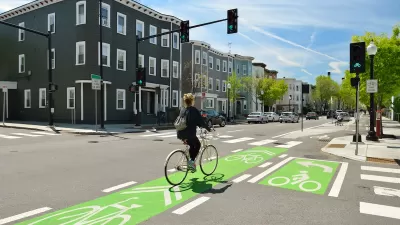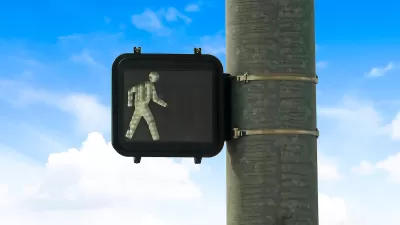The Sarah Debbink Langenkamp Active Transportation Safety Act was spurred by the death of a U.S. diplomat who was killed on her bicycle.

A bill introduced in the U.S. Congress would secure federal funding for bike and pedestrian infrastructure, reports Ginny Bixby in Bethesda Magazine.
The bill, the Sarah Debbink Langenkamp Active Transportation Safety Act, is named in honor of a U.S. diplomat who was killed while riding her bicycle and would allow states and cities to use up to 10 percent of Highway Safety Infrastructure Program funds for bike and pedestrian facilities.
According to Bixby, “This is the second attempt by Raskin and Van Hollen to gain passage of the bill. Last year, the bill didn’t make it onto committee agendas for a vote.” Advocates like Langenkamp’s husband say the bill could help small communities with limited budgets make critical safety improvements.
Maryland Governor Wes Moore signed a similar state act last year, honoring the legacy of Langenkamp, who resided in Bethesda. The law “imposed the same penalties for hitting a cyclist in a bike lane as for hitting a pedestrian or cyclist in a crosswalk – up to two months in jail, and a fine of up to $2,000.”
FULL STORY: Federal bill honoring Bethesda mom killed while cycling would help states fund road safety efforts

Manufactured Crisis: Losing the Nation’s Largest Source of Unsubsidized Affordable Housing
Manufactured housing communities have long been an affordable housing option for millions of people living in the U.S., but that affordability is disappearing rapidly. How did we get here?

Americans May Be Stuck — But Why?
Americans are moving a lot less than they once did, and that is a problem. While Yoni Applebaum, in his highly-publicized article Stuck, gets the reasons badly wrong, it's still important to ask: why are we moving so much less than before?

Using Old Oil and Gas Wells for Green Energy Storage
Penn State researchers have found that repurposing abandoned oil and gas wells for geothermal-assisted compressed-air energy storage can boost efficiency, reduce environmental risks, and support clean energy and job transitions.

Updating LA’s Tree Rules Could Bring More Shade to Underserved Neighborhoods
A new USC study finds that relaxing Los Angeles’ outdated tree planting guidelines could significantly expand urban tree canopy and reduce shade disparities in lower-income neighborhoods, though infrastructure investments are also needed.

California's Canal Solar Projects Aim to Conserve Resources and Expand Clean Energy
California’s Project Nexus has begun generating electricity from solar panels installed over irrigation canals, with researchers and state agencies exploring statewide expansion to conserve water and boost clean energy production.

HHS Staff Cuts Gut Energy Assistance Program
The full staff of a federal program that distributes heating and cooling assistance for low-income families was laid off, jeopardizing the program’s operations.
Urban Design for Planners 1: Software Tools
This six-course series explores essential urban design concepts using open source software and equips planners with the tools they need to participate fully in the urban design process.
Planning for Universal Design
Learn the tools for implementing Universal Design in planning regulations.
Heyer Gruel & Associates PA
City of Moreno Valley
Institute for Housing and Urban Development Studies (IHS)
City of Grandview
Harvard GSD Executive Education
Salt Lake City
NYU Wagner Graduate School of Public Service
City of Cambridge, Maryland





























